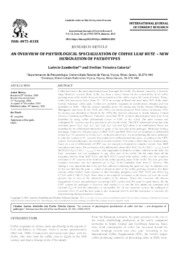An overview of physiological specialization of coffee leaf rust: new designation of pathotypes.
An overview of physiological specialization of coffee leaf rust: new designation of pathotypes.
Autoria: ZAMBOLIM, l.; CAIXETA, E. T.
Resumo: Coffee leaf rust is the most important disease thorought the world. The disease caused by a biotrofic fungi growing areas of the world coffee leaf rust causes losses from Central American coffee park. identified in 1860. Madagascar and Java). I the disease was identified in Brazil. America, Caribean and Mexico. Currently, more than 50 identified by using coffee differentials clones of CIFC in the world. The most comum and widespread resistance genes ( identified by the differential interaction of genes of the host and of the pathogen. M technique, found two different genes in HdT 832/1 and HdT 832/2 not yet identified in differential clones ( to refer the isolates of system. Several pathotypes was found in several countri based on a set of differentials of CIFC was not enough to characterize complex isolates from derivatives into races. HdT832 their resistance was not supplanted in any other part of the world. On the other hand all the progenies derived from HdT 832/1 and resistance to complete resistance was not suplanted yet is S finding is very important due to the fact that cultivars containing the gene by the race that has the gene v reasons coffee breders must consider in their br 6,7,8,9) growers has to rely on the designation of CIFC system the pathogen is recessive and virulent (v resistant ( avirulent (Avr1 characterizing the hypersensitive reaction. Hemileia vastatrix Berk. & Br. has been a serious threat for the sustainability of all coffee . It caused the destruction of the coffee crop in Sri Lanka (Ceylon). Today, 35 ? 50 % on average in Brazil and more tham 50% of the entire Coffee rust probably originates in southwestern Ethiopia and was Then the disease spreaded across the Indian and Pacific Oceans (Philippines, n the 1950s and 1960s, rust advanced across West Africa. In the 1970s-90s, leaf rust advanced to South America, Central H. vastatrix H. vastatrix race II is presente in all over the world. The CIFC diferential clones has nine SH1, SH2, SH3, SH4, SH6, SH7, SH8 and SH9) alone or in combination. Races are SH1-9), named as SH10 and SH11. In the present review, we are proposing the name pathotype H. vastatrix that could not be differentiated into races, according to the CIFC es. It became evident that race nomenclature The resistance of the differential clones HdT 832/1 (S /2 (SH 6,7,8,9,? - v6,7,8,9,?) was only supplanted in India by isolates colleted in the field; but HdT 832/2 cossed with ara H. vastatrix in the field in all the coffee growing areas of the world. The only gene that H3, in the dominant form, from 3, which is absent in most of the coffee growing countries. For these eeding programs cross HdT 832/1 and 832/2 (S with S 288-23 (SH3). Since there is no complete resistance to the disease all over the world chemical control of the disease. races and pathotypes according CIFIC system and Flor gene for gene theory. 1-9) and the host plants are dominant and SH1-9) and the interaction is susceptible (S). In our proposed syst -9) and the host plant is also dominant (SH1-9) and the interaction is resistant (R) In January 1970, physiological races have been olecular biology HdT H 6,7,8,9,? - v6,7,8,9,?) and bica coffee lost the complete C. liberica.
Ano de publicação: 2021
Tipo de publicação: Artigo de periódico
Unidade: Embrapa Café
Palavras-chave: Coffea, Hemileia Vastatrix, Leaf rust, Pathotypes
Observações
1 - Por padrão são exibidas publicações dos últimos 20 anos. Para encontrar publicações mais antigas, configure o filtro ano de publicação, colocando o ano a partir do qual você deseja encontrar publicações. O filtro está na coluna da esquerda na busca acima.
2 - Para ler algumas publicações da Embrapa (apenas as que estão em formato ePub), é necessário ter, no celular ou computador, um desses softwares gratuitos. Sistemas Android: Google Play Livros; IOS: iBooks; Windows e Linux: software Calibre.
Acesse outras publicações
Acesse a Base de Dados da Pesquisa Agropecuária (BDPA) para consultar o acervo completo das bibliotecas da Embrapa.

